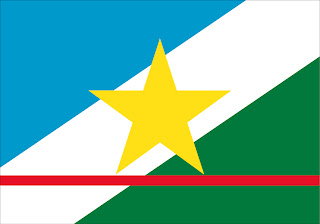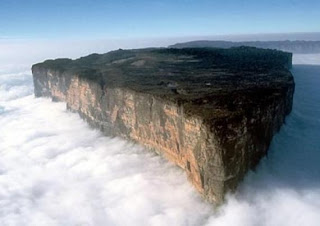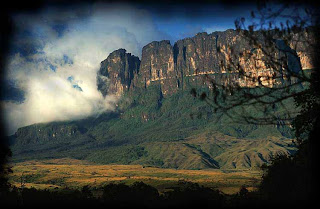In 1994 a British Army expedition to Borneo’s infamous Low’s Gully went disastrously wrong. Three books and one movie was made based on the event. As I have shared with you the three books, this time, I would like to share with you the movie. The movie is entitled “To The End of The Earth : The Abyss”, was produced in 1998 by a group of European actors.
Synopsis:
In 1994, a British Army expedition of 10 men set out to become the first to explore Low’s Gully in Borneo – a 1.6-kilometre-deep canyon, stretching for 10 kilometres off the side of Mount Kinabalu. Armed with 10 days’ rations and a video camera but without radio and flares, they descended into the abyss …
Setting Out
Low’s Gully was created over a million years ago when a massive glacier carved a huge canyon on the side of Mount Kinabalu in northern Borneo. Known as the ‘Place of the Dead’, local legend tells that it’s a resting place of their ancestors. Today, it remains one of the least explored gullies on the planet.
In 1994, Lieutenant Colonel Robert Neil and Major Ron Foster put together a team of 10 soldiers to explore the gully as part of a British Army expedition. The aim was to climb the mountain and abseil into the top of the gully, before trekking along it back to base – all in just six days.
The plan was to travel light, so they decided to forgo radios and flares and take just 10 days’ rations. Of the team, only one man, Lance Corporal Richard Mayfield, had any real climbing experience and two of the soldiers had never even abseiled before.
In February 1994, with just one day’s abseil training, the team began the 4100-metre ascent to the mountain’s summit. The path up was just 13 kilometres long but rose steeply. Regularly scaled by groups of tourists, Mount Kinabalu is not considered a tough climb. Yet it proved difficult for many of the soldiers who had spent only three days acclimatising to the heat, altitude and humidity.
On the morning of the third day, Operation Gully Heights reached the summit and the men saw for the first time the task ahead of them. Neil, recognising that the climb had taken its toll on some of the men, decided that Mayfield and the younger, fitter men should forge ahead and begin their descent down the gully, while the remaining five men rested before catching up. It was a decision that would divide the team for good.
Mayfield’s group began to abseil the 1.6 kilometres to the gully floor. Each of the five men carried a length of rope. The plan had been to leave the ropes in place as they descended to provide them with a means of ascent back out if they needed it.
But as Mayfield’s team pressed on, it became clear to him that with the two teams separated they would need to remove and reuse their ropes in order to reach the bottom of the gully. Reluctant to take this drastic step, and with no radio to contact his commanding officer in the first group, Mayfield climbed back up to inform Neil of their predicament. But with Neil’s team still too tired to begin their descent, he ordered Mayfield to continue to the gully floor, saying they would follow.
With just four days’ rations left, and with the team divided, Mayfield began to realise that Operation Gully Heights may have underestimated Low’s Gully. It was a point of no return. If they descended to the gully floor would they make it out again?
When Neil’s team finally began their descent they had only three days’ rations left. And with novice climbers, they made slow progress.
Meanwhile, at the bottom of the gully, the advance team were waiting for the others to catch up. But when they failed to show and with their rations running short they realised they were no longer on a training exercise. It had become a fight for human survival – they had to try and make it out of the forest alive.
As the first group began to negotiate their way out, they met with the gully’s unique weather system. Mists over the mountain gave way to torrential rains and with nowhere else to go, the water poured down into the gully. Soon, the stream that they had planned to follow out turned into rapids. Hemmed in by the forest, Mayfield’s team attempted to follow the fast-moving water, abseiling down waterfalls and traversing the sheer rock flanking the water.
Ahead of them, Mayfield’s team had become trapped between two waterfalls. Up to their waists in water, the drop ahead of them was too dangerous to attempt and they couldn’t climb back up the previous waterfall. So Mayfield, using his climbing skills, decided to tackle the 13-metre rock face that rises from the side of the gully.
But after he had safely helped his companions climb out of the gully, the five men found themselves face-to-face with an impenetrable forest thicket. In the days that followed, as they slowly struggled through the undergrowth, Mayfield and one other team member became separated from the other three in their group. Unable to find them, they were forced to continue on. With no rations, they attempted to live off the forest, but with dire consequences – Mayfield’s companion became violently ill. Unwilling to leave him behind, Mayfield goaded him into going on.
Eventually, after 17 days in the gully, the pair spotted what looked like a bridge. It turned out to be a road. Exhausted and starving, they stumbled out of the forest and back into the arms of civilisation.
On their return, they learned that the other three in their party had already made it back safely. But Neil’s team were still stranded. The Malaysian Army started to search for the missing soldiers with helicopters. A Royal Air Force rescue team was also dispatched.
After 10 days of searching, a Malaysian helicopter finally spotted the second group and lowered stretchers to rescue them. It was 31 days since they’d set out. By the end, they’d been surviving off energy sweets and cough drops. They had lost a fifth of their body weight, but they were alive.
All 10 men had survived the ordeal, but in their rush to be the first to explore the gully, they had overestimated their own abilities and underestimated the unique terrain and unpredictable weather of Low’s Gully.










